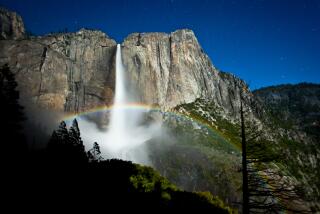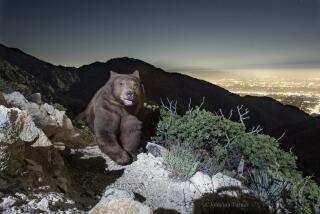Shoot the light
- Share via
Michael AMBROSE first envisioned the image he wanted to capture of a snow-covered El Capitan while on a summer hike above Yosemite Valley. Over the next three years, he cross-country skied to Dewey Point about 10 times, seeking just the right light and the perfect vantage point to make his photograph sing.
His vigilance paid off. Two years ago on New Year’s Eve, storm clouds broke up and swirled around the granite monolith. The resulting photo, snapped in filtered sunlight, has become what the professional landscape photographer says is his signature -- and bestselling -- image.
Nature photography is a way for outdoor enthusiasts to record their adventures and hopefully produce one-of-a-kind artwork worthy of space on their living room walls.
Amateurs beware: It’s a pursuit that can be fun and rewarding, but also expensive, frustrating and time-consuming. The closer you get to nature, the more compelling the urge to get the shot right -- and a few pointers from the pros may boost your chances.
Whether you use a digital point-and-shoot or a large-format 4-by-5 camera, as Ambrose does, the key to riveting outdoor images is good composition. That means the person behind the lens needs to start with a specific vision.
Ambrose, who lives in Clovis, Calif., and whose images have appeared in numerous galleries and art shows statewide, says making good photos takes work. He starts by scoping out the scene while hiking.
“When I go out, I’ll typically take a journal and sketch out compositions and thoughts on an area,” he says.
Time and patience eventually pay off, especially when it comes to finicky subjects such as the unpredictable timing of wildflower blooms.
Landscape photographer George Lepp, who lives in Los Osos, Calif., and is known for his vivid digital images, spent 15 years shooting the state flower for his latest book “Golden Poppies of California.”
The late photographer and mountain climber Galen Rowell recounts in his book “Mountain Light” how he once wallpapered his basement with dozens of interlocking topographical maps of the High Sierra, seeking obscure, unclimbed faces -- to both climb and photograph.
“Most amateur photographers think of landscapes simply as objects to be photographed. They tend to forget that they are never photographing an object, but rather light itself,” Rowell wrote. He referred to the soft light at dawn and dusk as his “magic hour.”
Ambrose advises studying how shadows play on rock and how shifts in the weather can add drama to an image. “There’s nothing more boring than bright blue sky,” he says, adding that evening light is “really the most dramatic.”
“Avoid [shooting in] the middle of the day like the plague,” says Rich Seeling, owner of West Coast Imaging in Oakhurst, Calif., where many pros get their images printed. Low light “gives subjects more volume,” he adds.
The type of camera to use depends on preference and pocketbook. Large-format 4-by-5 cameras are big, heavy and costly but tend to be the pros’ choice because the larger film yields a higher-quality print.
A 5-megapixel digital camera is capable of producing prints that maintain a high resolution when enlarged -- and it’s a lot lighter than a 4-by-5 -- but make sure it’s always accessible, says Ambrose. Keep it in a waist pack so you’re not scrounging through your backpack at crucial moments.
And a tripod and cable shutter release are essential for shooting landscapes.
Film type, processing and printing will greatly affect the quality of your image. Fujichrome Velvia and Provia are vibrant, pro-quality slide films that many landscape photographers prefer and are widely available. These produce images that are often vastly richer in color and depth than ordinary film.
Another quality pro slide film is Kodak’s Ektachrome VS (for very saturated colors).
“You can’t drop it off at Wal-Mart and expect to get a good image back,” Ambrose says.
Go to a custom lab for processing, then send the transparencies to a studio such as West Coast Imaging for high-quality prints. It’ll cost more -- an 8-by-10 color print made by an “apprentice” printer runs $35 -- but you may end up with something you’d be proud to put up on the wall.
To e-mail Julie Sheer or read her previous Outdoors Institute columns, go to latimes.com/juliesheer.
*
(BEGIN TEXT OF INFOBOX)
Capturing the wild Iliuk
Robert Glenn Ketchum describes how he got the shot in Alaska.
The Los Angeles-based photographer who uses a camera to express his environmental concerns shot “Iliuk Arm of Naknek Lake, Katmai” in 1998 from a small plane over Katmai National Park and Preserve in Alaska using a Pentax 645 (medium-format camera) with a 150mm lens and Fujichrome Velvia film.
“When you’re in the plane, things are happening very quickly -- there’s no such thing as going back. I was flying dead up the lake, approaching that river drainage between the mountains. It’s one of the more prominent summits in the park. I’d been seeing it at different angles before the flight.
“It was a beautiful day and I was enraptured at the pure good-day vibe of the whole scene because often the weather there is so rainy and overcast.
“At the point when we came up the lake far enough for the sky to become the reflection is when it happened. Land and water look like two separate images.
“The reason for going on a plane in Alaska and not shooting everything from the lakeshore or hillside is that the scale of the Alaskan landscape is so vast, it’s important that my photos convey some sense of that, the largeness of the wild environment. The lake is a mix of glacial and nonglacial streams, so instead of that pale, pale (glacial) blue, it’s somewhere in between and it’s greatly enhanced by the blue sky.”
-- Julie Sheer
*
Look to the pros
For nature at its best, check out how the pros (and talented amateurs) do it at:
Michael Ambrose,
www.michaelambrose.com
Jack Dykinga,
www.dykinga.com
Robert Glenn Ketchum,
www.robertglennketchum.com
George Lepp,
www.leppphoto.com
Vern Clevenger,
www.vernclevenger.com
Sierra Club Camera Committee,
www.angeles.sierraclub.org/camera
More to Read
Sign up for The Wild
We’ll help you find the best places to hike, bike and run, as well as the perfect silent spots for meditation and yoga.
You may occasionally receive promotional content from the Los Angeles Times.






